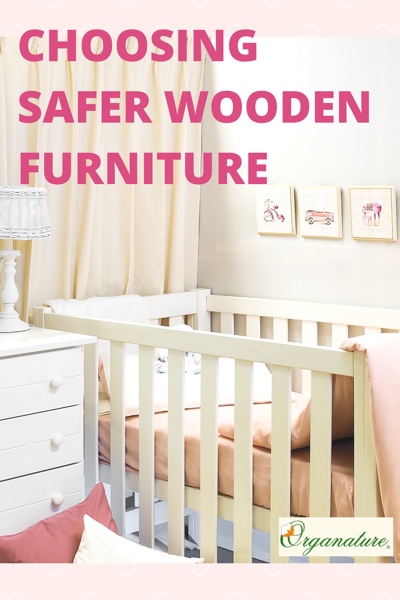 Why We Should Choose Non Toxic Wooden Furniture
Why We Should Choose Non Toxic Wooden Furniture
Did you know that many scientific studies have been done showing that the inside air quality in our homes can be significantly worse than the air outside quality. This frightening fact is one very good reason to make some healthy changes throughout our homes, and a significant enough reason as to why we should choose non toxic wooden furniture.
Our modern homes are often full of Volatile Organic Compounds, (VOC’s). These VOC’s off-gas from many different items found commonly inside our homes. Here is a list of just some of them;
- Phthalates from plastic vinyl products; e.g shower curtains, floors, blinds and even kids toys.
- Chemical based cleaning products and toxic air fresheners.
- Paints and varnishes that coat our wooden furniture
- Fabric dyes and stain-guards used to colour our carpets, couches, curtains and even our clothing.
- Flame retardants which have been impregnated into our carpets, blinds, mattresses, bedding, couches and yes even some of our clothing.
- Formaldehyde from compressed MDF/ Particle Board furniture – read this Australian Government Department of Health description
Formaldehyde Dangers In Pressed Wooden Furniture
These days, most wooden furniture is mass produced, think IKEA. This mass produced furniture is commonly made from compressed wood, in the forms of MDF, Particle Board and Plywood. To make these type of wooden furniture, they use resin containing Formaldehyde.
Formaldehyde is a colourless gas, found in the resins used as glues for sticking the wood sawdust together, so that it can then be compressed into wooden boards.
Formaldehyde exposure in the short term, causes irritation and burning to the eyes, nose and throat. In the long-term, exposure to Formaldehyde is linked to nose and throat cancers. Formaldehyde is recorded by the IRAC as a human carcinogen.
Unfortunately Formaldehyde use is widespread in the production of resins intended not just for use with wood products, but for paper, glasswool and rockwool. Formaldehyde is also used in the production of various, paints, varnishes, plastics, industrial chemicals and even in textile finishings. It is also used as a preservative (formalin), and as a disinfectant. Therefore it stands to reason, that the more ways we can minimise our daily exposure to Formaldehyde the better off we will be.
Builders at Risk from working with MDF & Particle Wooden Products
Those obviously at the biggest risks to Formaldehyde exposure, would be the workers that manufacture these wooden boards . Safety when working with these Formaldehyde containing resins is paramount.
Those next inline for dangerous exposure are the carpenters and builders. When they drill and saw into these wooden products, they often fail to wear appropriate clothing and the mandatory, filtration masks, and are therefore exposing themselves to high levels of formaldehyde.
Heat and sunlight can cause even more off-gasing of Formaldehyde from wooden furniture.
Newer MDF Furniture Releases More VOC’s Than Older MDF Furniture
Over time, compressed wooden furniture products, do thankfully, lower in the amount of VOC’s they release, but new MDF, or particle board furniture, will still releases unhealthy levels of VOC’s.
This is why if you are not going to take my advice below on choosing safer, wooden furniture, it is vitally important that you air brand new furniture for a few days outside. Once you bring it inside, ensure you have open windows and good air flow throughout your house, in order to minimize your families exposure to the VOC’s it off-gases.
VOC’s From Furniture Paints and Lacquers
Formaldehyde and other VOC’s are also released from the various paints and lacquers used to coat MDF/Particle Board furniture. Imported wooden furniture, from countries where safety regulations are questionable, e.g. Vietnam, Indonesia and China, are all too commonly coated in toxic paints and lacquers.
According to this this article by Business Insider Australia , imported wooden furniture is posing a very real health risk, with children, as always, being at the greatest risk.
Safe, Eco Friendly Wooden Furniture
Now knowing the above, when we buy wooden furniture, and especially for our bedrooms, and even more importantly for our children’s bedrooms, we need to put a little more thought and research into what we choose to buy.
There are furniture manufacturers around, that are aware of these VOC dangers and are doing their utmost to make safe wooden furniture, from sustainably sourced wood. One such company, who I have great admiration and respoect for, is the Victoria Australian based company Organature.
In my own home, I have my kids and I sleeping on their certified organic cotton mattresses, and we use all their certified organic cotton bedding. Recently when my son moved to a big bed, I had Organature make the wooden frame out of solid, Victorian Ash, Australian hardwood, from sustainable forest plantations.
Recently I asked Organature to make up two solid hardwood desks for my kids. I am confident in knowing that Organature do not use any cheap, toxic glues, paints or lacquers, instead they opt to use lacquers and finishes by the ethical company LIVOS,
LIVOS are considered the world leaders in producing natural, safe, eco-friendly, plant based finishes. They are transparent and clean about their ingredients.
So while you may pay a little more for solid wood, eco furniture, I believe it is well worth the investment, as you simply cannot put a price on your families, or your own health.
Before you leave, if you enjoyed this article sign up to LivingSafe and stay informed! LivingSafe helping you live healthier & safer.
Just a few other articles of interest below.
Synthetic Perfumes Making Us Sick
Dangerous Synthetic Air Fresheners And Choosing Safer, Healthier, Natural Options
Why Organic Food Really is Healthier.
Toxic Chemicals In Baby Personal Care Products & Choosing Safer Baby Skin Care
Keeping Your Home Free of Toxic Air Pollutants
Toxic Chemicals & Fire Retardants In Mattresses Making Us Sick